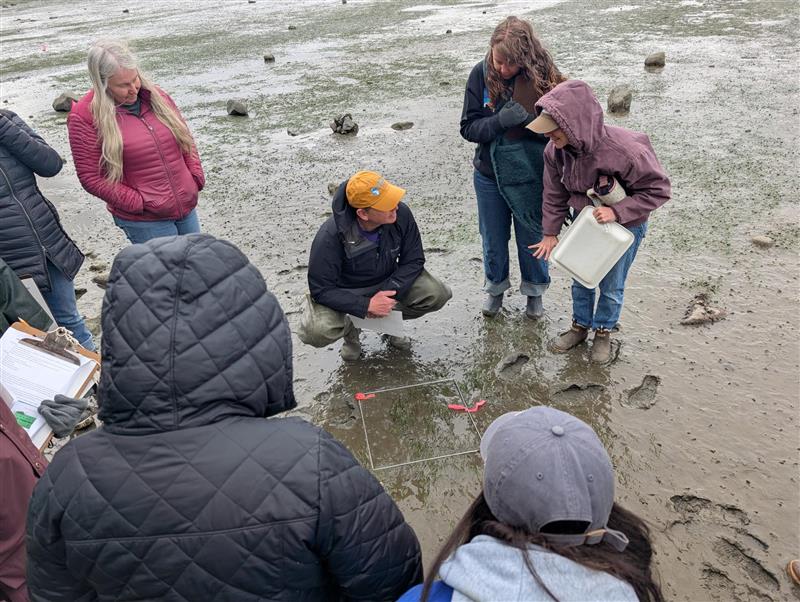Something you don’t hear every day, especially from teachers after a professional development workshop:
“I really enjoyed being in the mud.”
Of course, most professional development doesn’t involve mud, but this is PEI, so mud shouldn’t come as a surprise. That reaction is from one of twelve teachers from six northwest school districts who attended an in-person ‘Designing Field Investigations for Climate and Community’ workshop at Padilla Bay National Estuarine Research Reserve (PBNERR). The purpose was to teach principles of Next Generation Science Standards (NGSS) through field-based learning, using PEI’s Field Investigations guide.

A third goal was to help teachers understand climate issues impacting the mud flats and wetlands at PBNERR while making climate science transferable to the school yard, according to PEI’s Northwest FieldSTEM Coordinator Amy Keiper-Gowan. “This was a brilliant idea from Brian MacNevin, the Northwest ESD 189 science coordinator who has been teaching an NGSS 101 course for K-12 educators for many years,” she explains. “He wondered what would happen if we taught the same principles but through the pedagogy outdoor-based learning.”
Instead of beginning with NGSS standards and then conducting a field investigation, facilitators flipped the script. The day began with an exploration of the beach mud flats, with participants developing authentic questions based on the natural environment. They later classified those questions into three categories and analyzed their process through the lens of two NGSS standards: Science and Engineering Practices (SEPs) and Cross-Cutting Concepts.
“It was really encouraging to be with so many people who care about field-based learning and see the benefits to our community. The teachers want to know our ecological community better and to show students how to steward it.”
— Amy Keiper-Gowan, PEI’s Northwest FieldSTEM Coordinator
At the beach, the group conducted a batillaria survey. Such surveys are conducted frequently as part of ongoing research at Padilla Bay. Batillaria, also known as Japanese mud snails, are invasive, not native to the region, and their populations have fluctuated within PBNERR. Simultaneously, native eelgrass, which provides critical habitat for juvenile salmon, crab, herring, waterfowl and marine birds, is losing territory to non-native eelgrass in the bay, with climate change exacerbating the issue. Part of the Reserve’s current research is to better understand batillaria population variation, how it responds to environmental conditions like water temperatures, and its relationship to eelgrass populations. “This monitoring will help us understand how batillaria populations may respond to climate change, with implications for all the species they affect,” said PBNERR Natural Resources Coordinator Roger Fuller. “In terms of potential impacts, our biggest concerns are about the food web, and whether their disturbance of the mud surface (as they plow through the diatom “meadow”) might affect sediment gains/losses from the bay.”
“Each of the teaching team surveyed 50 feet of transect and collected data on how many live batillaria, an invasive snail, were present on the surface,” says Keiper-Gowan. “We looked for correlations between number and size of batillaria present and distance on the transect line. We found that there was a noticeable spike of batillaria numbers and size at one location on the transect, which only produced more questions. Why did more batilaria occur at this location than at other locations on the transect? Was it possible there were more battilaria under the surface? This cycle of investigation producing more questions that lead to additional investigations is part real field science and what the NGSS encourages.”
Guiding them through the inquiry process and helping them make classroom connections were not only Keiper-Gowan and MacNevin, but PBNERR director Jude Apple, and environmental educator Annie England. “Being on the mud flats with the director of Padilla Bay is not something teachers get to do very often,” says Keiper-Gowan. “These were teachers who have been to PEI trainings before and want to know about getting students out in the field, doing meaningful science work related to climate change and how it’s impacting their communities.”
Later, teachers discussed the Cross Cutting Concepts they experienced as a part of the day’s learning activities and the articulation of the CCC’s across K-12 grade levels to better understand how the CCCs intentionally build on each other. The day ended with collaborative grade level planning time to prepare their own field investigation for their students.
“It was really encouraging to be with so many people who care about field-based learning and see the benefits to our community,” says Keiper-Gowan. “The teachers want to know our ecological community better and to show students how to steward it.”
And also, have fun in the mud.
